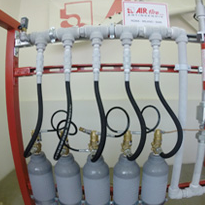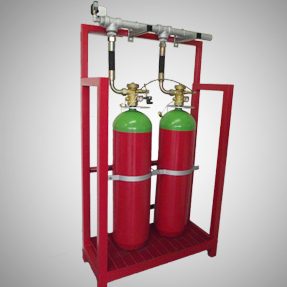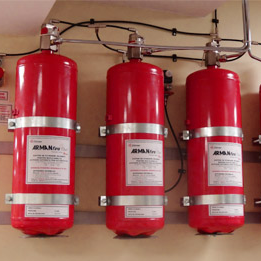
Historically most renowned and researched fire suppression agent, making it highly customizable according to the hazard being protected. Even though it is not ideal for human occupied spaces (mandatory safety precautions must be taken if people are present), it is the most effective gas for the suppression of a wide range of fires, Class A, B and C.
DESCRIPTION
Characteristics
- Colourless and odourless
- Chemically inert
- Electrically non conductive
- No residues upon discharge
- Easily refilled locally
- Low cost for unoccupied areas
Fire suppression mechanism
- Displacing oxygen content in the atmosphere, reducing oxygen concentration from 21% to 15% (for most applications).
- Cooling effect by removing sufficient heat from the fire.
Methods of application
- Total flooding application: consists in discharging a certain amount of carbon dioxide into a fixed enclosure up to prescribed concentration.
- Local application: when the burning hazard is relatively smaller compared to the volume of the enclosure, it is more effective to discharge the CO2 directly to the surface-type fires and potential deep-seated fire.
Typical hazards protected
Including but not limited to:
- Marine industries: engine rooms, paint lockers, vehicle transport areas on cargo vessels, flammable liquid storage areas.
- Heavy industries: rolling mill, control rooms, sheet printing, particle board chippers, cable trays, electrical room, motor control centres, nuclear power facilities, waste storage facilities, etc.
OUR SYSTEM
Complete High Pressure systems (57 bar @ 20 ºC) using 67 litre cylinders with all the necessary components, all that is missing is the piping and the installation. Depending on the risk(s) being protected, various configurations can be designed:
- Modular systems (one cylinder configuration)
- Bank systems (multiple cylinder configuration)
- Selector valve systems (one system configured to protect various risks)
Check out its key features:
- Compact valve technology: allows using the standard cylinder transportation safety cap, avoids using special caps and adapters.
- Direct release circuit: outlet connection to activate the slave cylinders from the master valve, eliminating the pilot cylinder and relief screw (except selector valve configuration).
- Maintenance at its safest: all components may be assembled and disassembled whilst under pressure, this includes: pressure gauge, pneumatic release, manual release and solenoid valve.
- Discharge-free commissioning system: whilst performing system functional testing during commissioning, the release circuit can be disconnected from the valves avoiding any accidental discharge and allow easy testing.
- Standing strong and secure: stand alone or wall mounted brackets with several configurations available, adapting the system to the room space.
- Flexible and resistant: all release and discharge hoses take into account the best balance between flexibility and durability, allowing easy installation and strength to withstand the pass of time.
- Spare-parts free: upon discharge or during maintenance, no rupture disks, nor special components must be replaced. Reducing down-time and lowering warehousing costs.
- Differential pressure actuation: allows using the same pressure from the cylinder to maintain the valve closed, reducing dramatically leakage problems even with high temperature fluctuations.
- Optimized standardization of systems: common components between systems reduces quantities needed hence saving on warehousing costs and allowing fast delivery to clients locally.
STANDARD AND CERTIFICATIONS
Our engineers are prepared to design the CO2 fire suppression projects according to the required standard:
- NFPA 12:2011
- CEA4007
- APSAD R13
Resources
With the continuous concerns regarding environmental impact and international treaties such as the Montreal Protocol and the Kyoto Protocol, have been put into place regulating gases that can be used, amongst other industries, in fire suppression applications, hence reducing ozone depletion as well as having no greenhouse effect potential.
Inert gases are recognized for being 100% eco-friendly being naturally available in the air that we breathe. They are not toxic for humans , they do not release dangerous substances when in contact with fire, visibility is not impaired, there’s no fogging and do not release residues post discharge.
DESCRIPTION
Characteristics
- Easily refilled locally.
- Electrically non conductive.
- High pressure filling, allows for delocalized cylinder location from the protected risk.
- Can be configured to protect various risks with only one system.
- Visibility is not reduced upon discharge.
- Ability to reach hidden fires.
Fire suppression mechanism
Cutting off or diluting the source of oxygen, reducing its concentration to below 15%, extinguishing the fire in 60 seconds.
Methods of application
Since fire is suppressed by reducing the concentration of oxygen in the air, achieved by increasing the concentration of the inert gas discharged, these gases can only be applied by total flooding, requiring minimum air tightness in the room.
Typical hazards protected
Including but not limited to Data Centres, server rooms and general IT facilities, telecommunications, industrial risks, libraries, archives, museums, art galleries, flammable liquids storage, transformer rooms.
OUR SYSTEM
Depending on the risk(s) being protected, various configurations can be designed:
- Modular cylinder (one cylinder set up)
- Bank system (multiple cylinder set up)
- If several hazards have to be protected, one bank system can be used along with selector valves.
All 4 inert gases are available at storage pressures of 200 and 300 bar in either 80 litre or 140 litre cylinders, the working pressure is reduced to 60 bar when entering piping network.
- IG-01, Argon
- IG-100,Nitrogen
- IG-55, 50% Nitrogen + 50% Argon
- IG-541,50% Nitrogen + 42% Argon + 8% CO2
Check out its key features:
- Compact valve technology; allows using the standard cylinder transportation safety cap, avoids using special caps and adapters.
- Direct release circuit; outlet connection to activate the slave cylinders from the master valve, eliminating the pilot cylinder and relief screw (except selector valve configuration).
- Maintenance at its safest; all components may be assembled and disassembled whilst under pressure, this includes: pressure gauge, pneumatic release, manual release and solenoid valve.
- Discharge-free commissioning system, whilst performing system functional testing during commissioning, the release circuit can be disconnected from the valves avoiding any accidental discharge and allow easy testing.
- Standing strong and secure; stand alone or wall mounted brackets with several configurations available, adapting the system to the room space.
- Flexible and resistant; all release and discharge hoses take into account the best balance between flexibility and durability, allowing easy installation and strength to withstand the pass of time.
- Spare-parts free; upon discharge or during maintenance, no rupture disks, nor special components must be replaced. Reducing down-time and lowering warehousing costs.
- Differential pressure actuation allows using the same pressure from the cylinder to maintain the valve closed, reducing dramatically leakage problems even with high temperature fluctuations.
- Optimized standardization of systems, common components between systems reduces quantities needed hence saving on warehousing costs and allowing fast delivery to clients locally.
STANDARD AND CERTIFICATIONS
Our engineers are prepared to design the inert fire suppression projects according to the required standards:
- NFPA 2001: 2015
- EN15004: 2008
- APSAD R13
- CEA 4008
Documents
Certifications:
Contact us for further details regarding our certificates.
DESCRIPTION
Characteristics
- Will completely extinguish Class A, B and C fires in seconds.
- Effective at low temperatures (-18 ºC).
- Ideal for retrofitting existing Halon 1301 installations.
- Colourless, odourless and electrically non-conductive.
- Leaves no residue, eliminating costly, post-fire clean-up and keeping down-time to a minimum.
- Most cost/ effective solution due to its low molecular weight.
Typical hazards protected
HFC-125 is suitable for data and telecommunication centres, clean rooms, operating rooms, data archives, computer rooms, art and historical artefacts, and cold storage.
OUR SYSTEM
AIRfire uses high pressure technology in a wide range of cylinder sizes, 26 litre to 120 litre pressurized at 42 bar, as well as high capacity 240 litre cylinders at 25 bar. This variety of cylinder sizes allows great flexibility when designing for hazards of different volumes, allowing that the most adequate solution is always applied.
AIRfire supplies complete systems with all the necessary components for fast, safe and easy assembly. The only thing that has to be added is the piping which will be defined in the hydraulic calculations delivered with the system.
STANDARD AND CERTIFICATIONS
The components as well as the systems assembled with them have been verified and approved by the following independent, third-party bodies:
- UL listed, according to UL 2166 “Halocarbon Clean Agent Extinguishing system units”
- CE marking according to EN12094
DESCRIPTION
Characteristics
- Completely extinguishes Class A, B and C fires in seconds.
- Works by physically cooling the fire at the molecular level.
- Colourless, odourless and electrically non-conductive.
- Leaves no residue, eliminating costly, post-fire clean-up and keeping down-time to a minimum.
- Advantageous filling density, reducing cylinder footprint.
- Ideal in total flooding situations.
Typical hazards protected
HFC-227, recognized by ASHRAE as HFC-227ea, is suitable for use in rooms, vaults, enclosed machines, containers, storage areas or wherever fixed enclosures are used. It can be used to protect electronic and delicate equipment. HFC-227 is extremely useful in applications where damages by other extinguishing methods would be prohibitive.
OUR SYSTEM
AIRfire uses high pressure technology in a wide range of cylinder sizes, 26 litre to 120 litre pressurized at 42 bar, as well as high capacity 240 litre cylinders at 25 bar. This variety of cylinder sizes allows great flexibility when designing for hazards of different volumes, allowing that the most adequate solution is always applied.
AIRfire supplies complete systems with all the necessary components for fast, safe and easy assembly. The only thing that has to be added is the piping which will be defined in the hydraulic calculations delivered with the system.
STANDARD AND CERTIFICATIONS
The components as well as the systems assembled with them have been verified and approved by the following independent, third-party bodies:
- UL listed, according to UL 2166 “Halocarbon Clean Agent Extinguishing system units”
- CE marking according to EN12094

Where the hazards needed to be protected are enclosed in small volumes/ voids, making the use of normal fixed fire suppression systems complicated and inadequate.
For this reason, AIRfire has decided to develop a specific system for these particular applications guaranteeing ease of design, installation and maintenance and, of course, appropriate extinguishing capabilities.
DESCRIPTION
Characteristics
- Precise installation around critical fire sources. Fire suppression agent is transported through a special hi-tech polymer tube exactly to the origin of the fire.
- The flexible polymer tube is heat sensitive along its entire length, which is the equivalent of having a full detection line.
- High and low pressure systems available with Carbon Dioxide and HFC-227 agents offering most adequate solutions for each application, ensuring no corrosion, electrical non conductivity and no production of residues upon discharge.
- New valve technology, incorporating integrated ball valve and pressure regulated exit (high pressure systems) avoid accidental discharges during transportation, manipulation and installation.
- No external power supply required. System is 100% pneumatically / mechanically actuated.
OUR SYSTEM
The ARMANfire systems offer cost effective protection which ensure fast fire response, detection and suppression all-in-one. 24 hours / 365 days nonstop stand alone monitoring of the hazard in question ensures immediate action at the origin of the heat-source, preventing collateral damage.
Specifically designed for small voids market niche, where normal fixed systems are poor in performance. They have been designed according International Standards, and assembled in such a way they are delivered as kits with all the necessary components and tools to install easily and rapidly.
Check out its key features:
- Pre-engineered: you will receive all the necessary material for installation as a ready to assemble kit.
- Maintenance and installation: you will receive the starter kit tool box with all necessary tools for the adequate system installation and maintenance.
- Promotion: AIRfire supports the promotion of these systems, by providing demo kits as well as assisting in the designing of small showrooms to carry out real tests.
Two main configurations are available:
- Tube Discharge Systems, the sensor tube acts as detection and fire suppression, self-activating the system. Ideal for very small volumes.
- Nozzle discharge systems, the sensor tube acts as detection and once it has burst, the extinguishing agent is discharged through a separate pipe and nozzles.
Applications
ARMANfire systems have the advantage to attack the fire by total flooding discharge but acting directly at the fire source. Most common applications are electrical cabinets, telecommunication racks, control panels, CNC machines to name a few.
STANDARD AND CERTIFICATIONS
The components as well as the systems assembled with them have been verified and approved by the following independent, third-party bodies:
- UL listed HFC-227 agent.
- Pi (π) marking, according to TPED 2010/35/EU
Our engineers are prepared to design the ARMANfire fire suppression projects according to the required standard:
- NFPA 2001: 2015, NFPA 17: 2013 and NFPA 17A: 2013
- EN15004: 2008
- AS 5062
- FM 5970

Thanks to the technological capabilities of the ARMANfire base systems, AIRfire decided to go one step further and develop a system specific for Kitchen equipment protection. Named ARMANfire Chef it includes all the characteristics and key features listed before, with the added feature that it uses the more appropriate wet chemical agent.
Characteristics:
- Cooling caused by heat vaporisation.
- The fine spray discharge prevents the dangerous splash of hot grease/ oil or thermal shock damage to cooking appliances.
- High-rate protection, up to 45 litres of burning oil covered by only one nozzle.
- Re-ignition is prevented by a process in which the wet chemical agent combines with the grease to form a soapy layer at the surface sealing off the fuel from the oxygen, allowing the grease to cool to below its auto-ignition temperature.
- Eco-friendly AFFF agent with quick biodegradability, up to 72% after 3 days and needs less oxygen to achieve it complete (>99%). Free of PFOS and PFAS.




